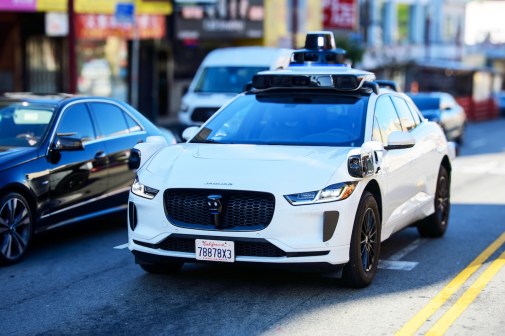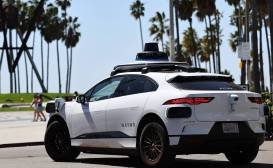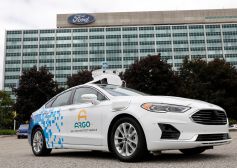How self-driving vehicles will transform the transit business model

With so many of America’s roads and highways supported by taxes on gas and car ownership, experts predict self-driving vehicles will redefine how the nation funds its transportation infrastructure.
This was the big takeaway Wednesday as a panel of transportation officials gathered at Smart Cities Week in Santa Clara, California, to discuss how cities and states can prepare for the impending arrival of autonomous vehicles. Nevada Department of Transportation Deputy Director Tracy Larkin-Thomason identified this major disruption in the government’s business model as part of a laundry list of likely impacts once the technology becomes consumer-ready.
The loss in funding, she said, will be felt from an absence of vehicle registration payments and renewals, losses in gas tax revenues from the vehicles’ electric engines and drops in ridership for regular city transit systems.
“One of the things that state departments of transportation are looking at is basically, ‘How are we are going to continue to fund the infrastructure to support this [change in vehicle ownership]?’” Larkin-Thomason said. “For example, in Las Vegas, in just one year, Uber and Lyft have taken over 27 percent of the taxi services, and for the first time in years, our transit [business] model along the strip is actually in the red and not in the black.”
She warned such impacts would, at least temporarily, have detrimental affects on state and city transportation systems as agencies recalibrate policies and revenue sources to fit the new technology.
“It’s that transition period that we always don’t talk about a lot,” Larkin-Thomason said. “We always look at the long-term effects and if we could suddenly wave a wand and everything was autonomous and connected vehicles, that would be great. But in that transition period — until we have at least 20 percent penetration of the market — we’re basically going to be looking at a downturn in the performance of the system.”
Further, she said that there are likely to be a number of new costs tied to the vehicles, like clearer striping and signage to mark roadways, additional staff capacity to coordinate with insurance companies about how vehicles can qualify for insurance, and potential legal liabilities municipalities may face when vehicle performance is even more dependent on the quality and upkeep of city streets.
Adam Stocker, a mobility researcher at the UC Berkeley Transportation Sustainability Research Center, said cities may encounter additional costs through a new level of commuting. The convenience of autonomous vehicles could entice people to drive longer distances to work and this would result in denser cities, an issue that may become a weight on government resources and services — especially since the crowding will be generated by people who are not necessarily tax-paying city residents.
“One of the potential negative effects of automated vehicles is super sprawl,” Stocker said. “Any time you make a transportation facility or service better, you induce more travel where people don’t mind traveling farther distances to commute to work, and this may cause a whole other level of sprawl that was never expected.”
Across state lines
Speakers also stressed the challenge of finding a set of standards that will allow self-driving vehicles to move between cities and states without modifying vehicles or drastically changing operating procedures. Vine White, a former deputy assistant secretary at the U.S. Department of Transportation (DOT) now working as a transportation specialist for Deloitte, said in the panel that states are struggling to agree on regulations that would permit self-driving vehicles to move between borders. Under the Obama Administration, White led the DOT’s effort to design guidelines that states might use to streamline policies.
But these guidelines were not compulsory and states must collaborate to find a solution, he said.
Complicating matters there is no government or nonprofit organization that the panelists could identify as a consensus builder. Former Transportation Anthony Foxx was in the middle of a collaboration effort between the autoindustry, states and other stakeholder before he left office, but since the Trump Administration took office, all this work has been sidelined. Trump’s DOT Secretary, Elaine Chao, has not endorsed Foxx’s guidelines or released a new strategy. In an interview with Bloomberg News on May 3, Chao said that while she understood the benefits and worried about differences between states, she said she did not want hasty regulations to interfere with the technology’s development.
White estimated that a state-to-state consensus will happen in the same way officials collaborated on vehicle transponders for tolling in the late 90s. Today, TransCore offers passes for tolls in 19 states or more, offering but a modicum of consistency across state lines.
“You had an E-Z Pass in the Northeast, you had a SunPass in the Florida region, you had something different in Texas, and pretty soon if you wanted to drive around the country you had to have five or six transponders on your windshield,” White said. “So how does that kind of stuff become interoperable? Well, I’m really keen on what this eventual multi-state approach will be.”
The panelists were unanimous in their support of self-driving vehicles as a means to alleviate hardships tied to population growth and rising living costs. Doug Johnson, a transportation planner for Northern California’s Bay Area Metropolitan Transportation Commission, said that even with its challenges, the new technology offers a remedy to otherwise inexorable problems.
More productivity, cleaner air, less traffic, no vehicle loans and greater safety each stand out among the key benefits of self-driving vehicles.
“I think new vehicle technology does provide an amazing opportunity to remedy longstanding shortfalls in private auto ownership,” Johnson said. “There are huge environmental impacts here. Over 40 percent of the Bay Area’s emission come from private vehicles, tens of thousands of people unfortunately die on our roads every year and we spend tens of thousands of hours in the Bay Area stuck in traffic. … Let’s be frank. This is probably is one of the most exciting times to be a transportation planner — or geek — in a very long time.”






